
Rabbit Anti-AIF antibody
Apoptosis inducing factor; Harlequin; Hq; mAIF; MGC111425; MGC5706; PDCD 8; PDCD8; Programmed cell death 8; Programmed cell death 8 isoform 1; Programmed cell death 8 isoform 2; Programmed cell death 8 isoform 3; Programmed cell death protein 8 mitochondr
View History [Clear]
Details
Product Name AIF Chinese Name 调亡诱导因子抗体 Alias Apoptosis inducing factor; Harlequin; Hq; mAIF; MGC111425; MGC5706; PDCD 8; PDCD8; Programmed cell death 8; Programmed cell death 8 isoform 1; Programmed cell death 8 isoform 2; Programmed cell death 8 isoform 3; Programmed cell death protein 8 mitochondrial; Programmed cell death protein 8 mitochondrial precursor; Striatal apoptosis inducing factor; AIFM1_HUMAN; Apoptosis-inducing factor 1, mitochondrial. literatures Research Area Tumour Cell biology Chromatin and nuclear signals Neurobiology Apoptosis Cyclin Mitochondrion Immunogen Species Rabbit Clonality Polyclonal React Species Human, Mouse, Rat, Pig, (predicted: Chicken, Dog, Cow, Rabbit, Sheep, ) Applications WB=1:500-2000 ELISA=1:5000-10000 IHC-P=1:100-500 IHC-F=1:100-500 IF=1:100-500 (Paraffin sections need antigen repair)
not yet tested in other applications.
optimal dilutions/concentrations should be determined by the end user.Theoretical molecular weight 57kDa Cellular localization The nucleus cytoplasmic Mitochondrion Form Liquid Concentration 1mg/ml immunogen KLH conjugated synthetic peptide derived from human AIF: 131-230/613 Lsotype IgG Purification affinity purified by Protein A Buffer Solution 0.01M TBS(pH7.4) with 1% BSA, 0.03% Proclin300 and 50% Glycerol. Storage Shipped at 4℃. Store at -20 °C for one year. Avoid repeated freeze/thaw cycles. Attention This product as supplied is intended for research use only, not for use in human, therapeutic or diagnostic applications. PubMed PubMed Product Detail This gene encodes a flavoprotein essential for nuclear disassembly in apoptotic cells, and it is found in the mitochondrial intermembrane space in healthy cells. Induction of apoptosis results in the translocation of this protein to the nucleus where it affects chromosome condensation and fragmentation. In addition, this gene product induces mitochondria to release the apoptogenic proteins cytochrome c and caspase-9. Mutations in this gene cause combined oxidative phosphorylation deficiency 6, which results in a severe mitochondrial encephalomyopathy. Alternative splicing results in multiple transcript variants. A related pseudogene has been identified on chromosome 10. [provided by RefSeq, May 2010].
Function:
Probable oxidoreductase that has a dual role in controlling cellular life and death; during apoptosis, it is translocated from the mitochondria to the nucleus to function as a proapoptotic factor in a caspase-independent pathway, while in normal mitochondria, it functions as an antiapoptotic factor via its oxidoreductase activity. The soluble form (AIFsol) found in the nucleus induces 'parthanatos' i.e. caspase-independent fragmentation of chromosomal DNA. Interacts with EIF3G,and thereby inhibits the EIF3 machinery and protein synthesis, and activates casapse-7 to amplify apoptosis. Plays a critical role in caspase-independent, pyknotic cell death in hydrogen peroxide-exposed cells. Binds to DNA in a sequence-independent manner.
Subunit:
Interacts with XIAP/BIRC4. Interacts (via N-terminus) with EIF3G (via C-terminus).
Subcellular Location:
Mitochondrion intermembrane space. Mitochondrion inner membrane. Cytoplasm. Nucleus. Cytoplasm, perinuclear region. Note=Proteolytic cleavage during or just after translocation into the mitochondrial intermembrane space (IMS) results in the formation of an inner-membrane-anchored mature form (AIFmit). During apoptosis, further proteolytic processing leads to a mature form, which is confined to the mitochondrial IMS in a soluble form (AIFsol). AIFsol is released to the cytoplasm in response to specific death signals, and translocated to the nucleus, where it induces nuclear apoptosis. Colocalizes with EIF3G in the nucleus and perinuclear region.
Tissue Specificity:
Isoform 5 is frequently down-regulated in human cancers.
Post-translational modifications:
Under normal conditions, a 54-residue N-terminal segment is first proteolytically removed during or just after translocation into the mitochondrial intermembrane space (IMS) by the mitochondrial processing peptidase (MPP) to form the inner-membrane-anchored mature form (AIFmit). During apoptosis, it is further proteolytically processed at amino-acid position 101 leading to the generation of the mature form, which is confined to the mitochondrial IMS in a soluble form (AIFsol). AIFsol is released to the cytoplasm in response to specific death signals, and translocated to the nucleus, where it induces nuclear apoptosis in a caspase-independent manner.
Ubiquitination by XIAP/BIRC4 does not lead to proteasomal degradation. Ubiquitination at Lys-255 by XIAP/BIRC4 blocks its ability to bind DNA and induce chromatin degradation, thereby inhibiting its ability to induce cell death.
DISEASE:
Combined oxidative phosphorylation deficiency 6 (COXPD6) [MIM:300816]: A mitochondrial disease resulting in a neurodegenerative disorder characterized by psychomotor delay, hypotonia, areflexia, muscle weakness and wasting. Some patients manifest prenatal ventriculomegaly and severe postnatal encephalomyopathy. Note=The disease is caused by mutations affecting the gene represented in this entry.
Similarity:
Belongs to the FAD-dependent oxidoreductase family.
SWISS:
O95831
Gene ID:
9131
Database links:Entrez Gene: 51060 Human
Entrez Gene: 9131 Human
Entrez Gene: 26926 Mouse
Omim: 300169 Human
SwissProt: O95831 Human
SwissProt: Q9Z0X1 Mouse
AIF是一种易位到The nucleus诱导凋亡的Mitochondrion蛋白, AIF可引起DNA破碎、染色质凝聚,还可诱导细胞色素C和Caspase-9从Mitochondrion中释放出来,AIF从Mitochondrion中的释放可被过度表达的Bcl-2(一种参与Mitochondrion渗透的蛋白质)所抑制。Product Picture
Liver (Mouse) Lysate at 40 ug
Primary: Anti-AIF (SL 0037R) at 1/300 dilution
Secondary: IRDye800CW Goat Anti-Rabbit IgG at 1/20000 dilution
Predicted band size: 57 kD
Observed band size: 63 kD
Sample: K562 Cell Lysate at 40 ug
Primary: Anti-AIF (SL0037R) at 1/300 dilution
Secondary: IRDye800CW Goat Anti-Rabbit IgG at 1/20000 dilution
Predicted band size: 57 kD
Observed band size: 63 kD
Sample:
Kidney (Mouse) Lysate at 40 ug
Primary: Anti-AIF (SL 0037R) at 1/300 dilution
Secondary: IRDye800CW Goat Anti-Rabbit IgG at 1/20000 dilution
Predicted band size: 57 kD
Observed band size: 63 kD
Sample:
Lane 1: K562 (Human) Cell Lysate at 30 ug
Lane 2: Testis (Rat) Lysate at 40 ug
Lane 3: Testis (Mouse) Lysate at 40 ug
Primary: Anti-AIF (SL0037R) at 1/1000 dilution
Secondary: IRDye800CW Goat Anti-Rabbit IgG at 1/20000 dilution
Predicted band size: 67’62’57 kD
Observed band size: 62 kD
Partial purchase records(bought amounts latest0)
No one bought this product
User Comment(Total0User Comment Num)
- No comment
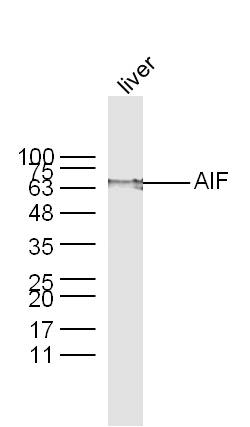
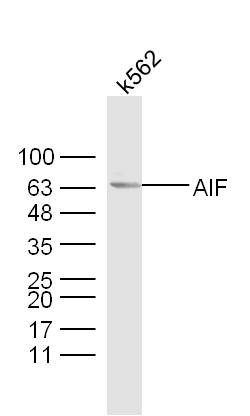
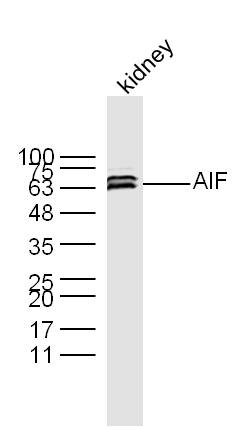
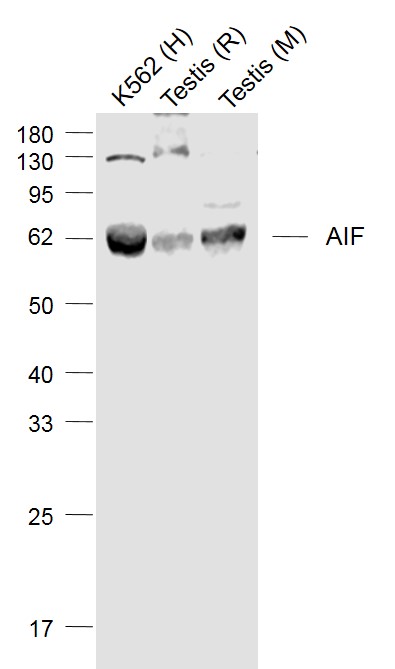
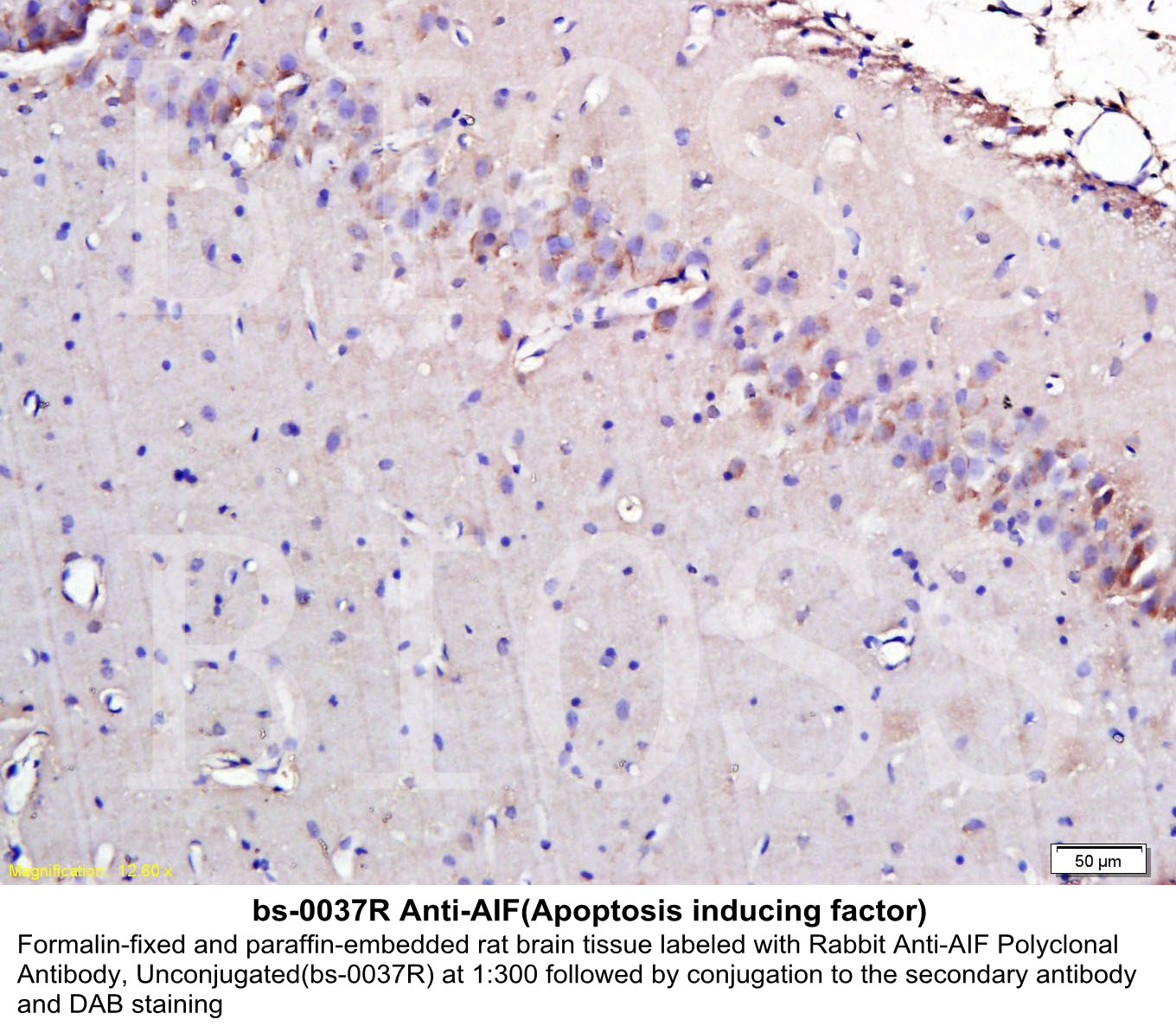
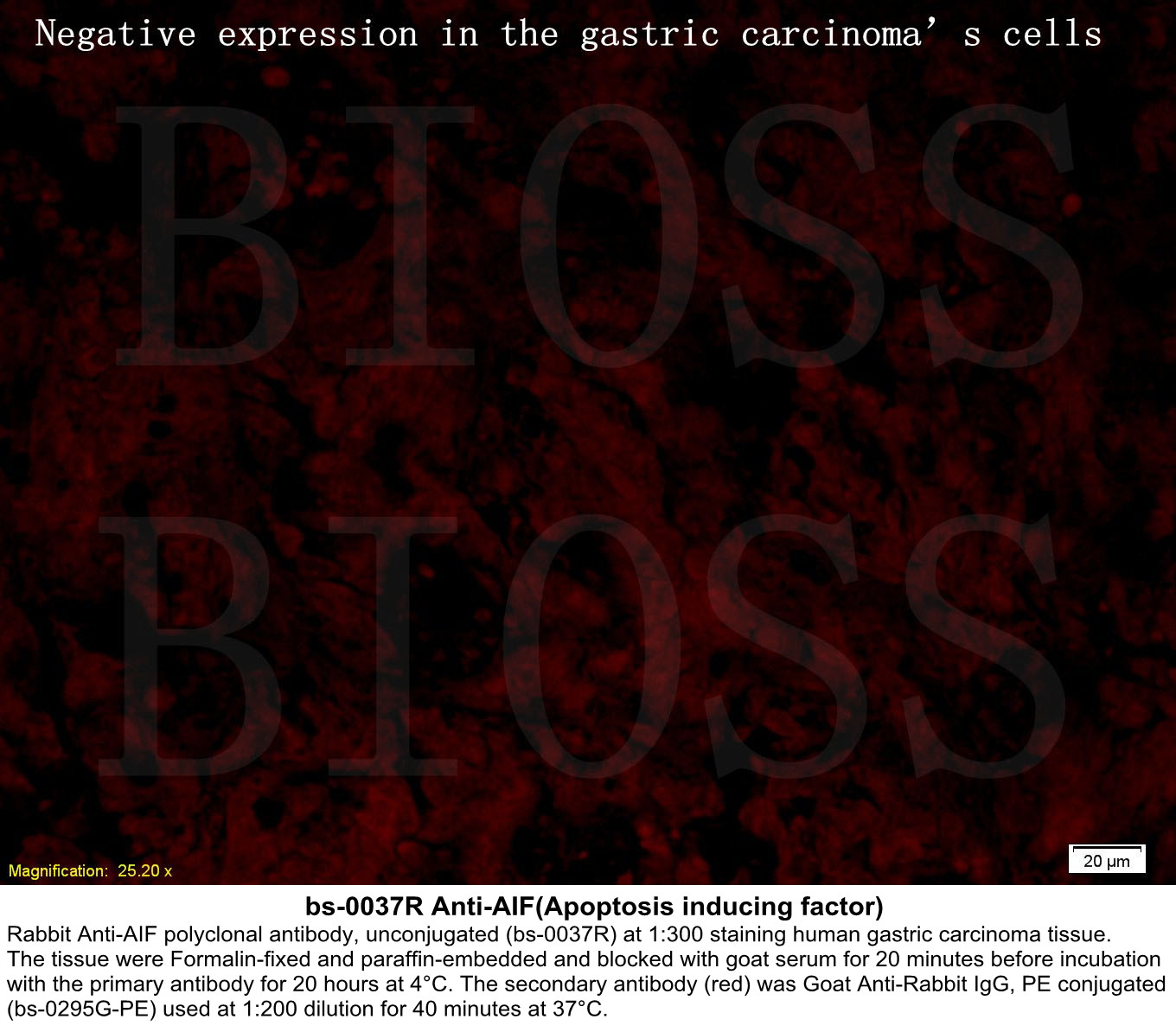
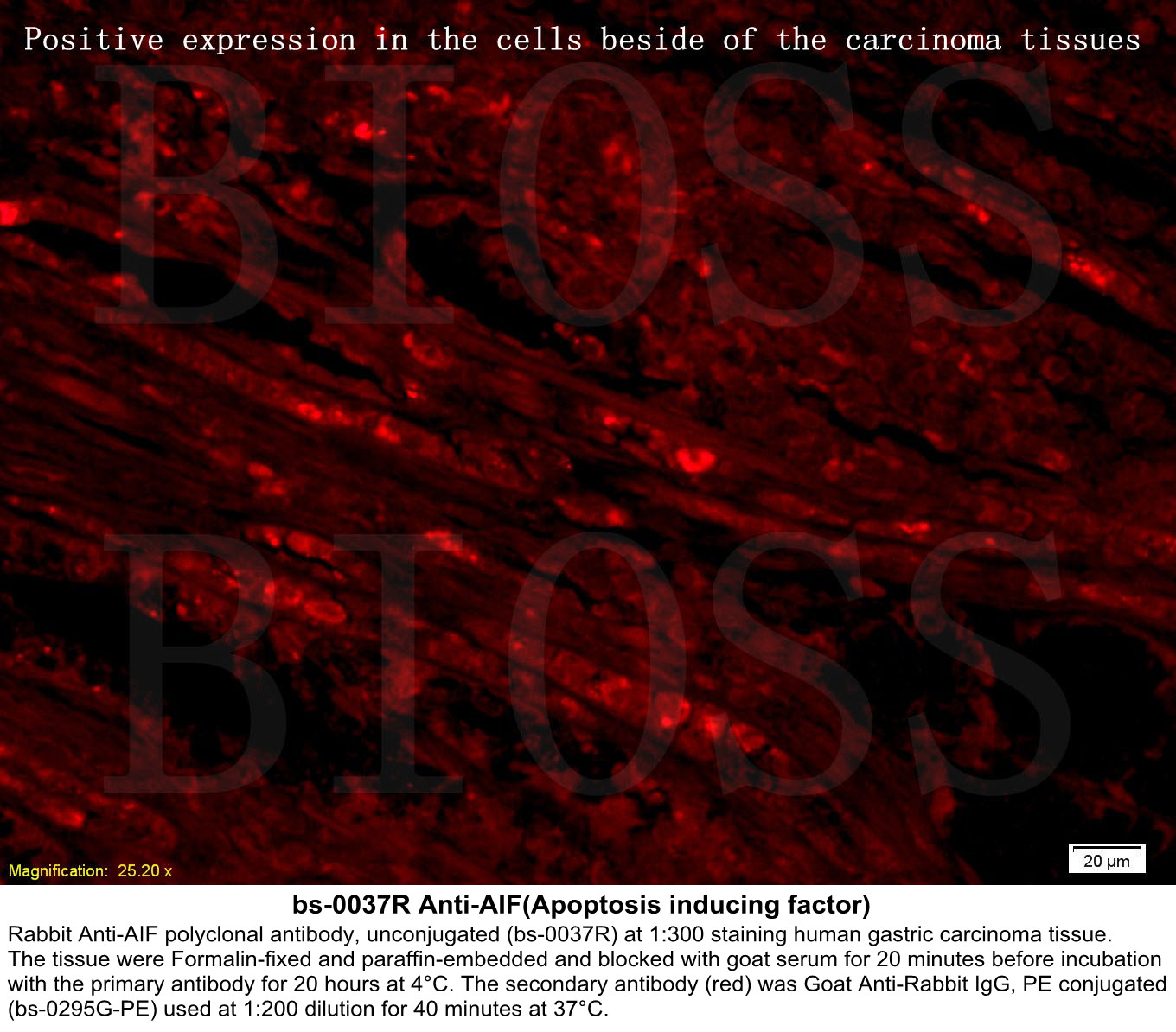


 +86 571 56623320
+86 571 56623320




